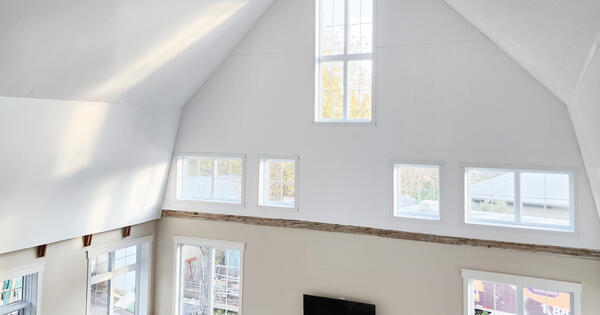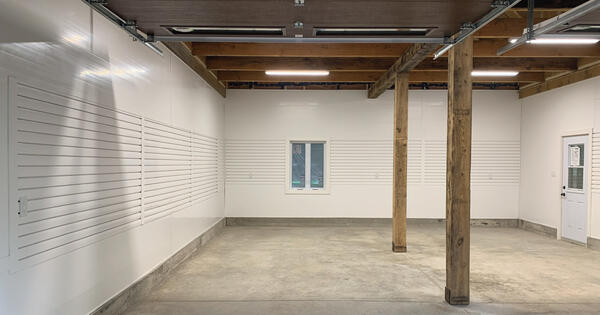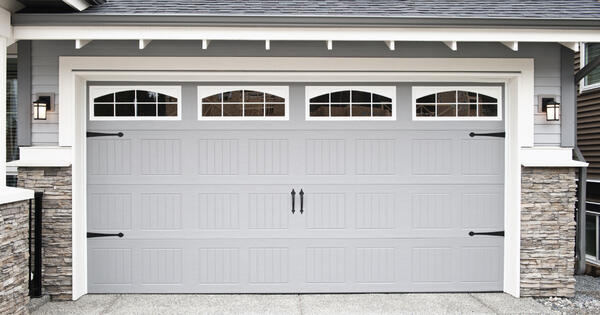This post was originally published in August 2022. Last updated: July 2025.
A pole barn is a type of post-frame building that uses large posts buried in the ground to support the roof and structure — no basement or traditional foundation required. That makes it a cost-effective, flexible solution for everything from agricultural storage and animal shelters to residential garages, workshops, and even homes like barndominiums.
While the structure itself is straightforward, what you do with the interior plays a big role in how functional and long-lasting your pole barn will be. Interior finishes don’t just impact how the space looks. They also help protect the building from wear and tear, make it easier to clean, and can even improve the barn’s usability and resale value. Not every material is up to the task, though. When it comes to pole barn interiors, choosing the right wall and ceiling finish is key to getting the best performance out of the space.
Why Finish the Interior of a Pole Barn?
Finishing the inside of your pole barn isn’t just about making it look good, it’s about making it work better for the long haul. Whether you plan to use the space as a workshop, garage, storage area, or something more livable, finishing the interior adds practical value.
Here are some of the main reasons it’s worth the investment:
- Protect insulation and structural components: Covering the interior walls and ceiling helps shield insulation, framing, and wiring from accidental damage, pests, and moisture.
- Improve lighting and aesthetics: Smooth, light-colored finishes reflect more light, which makes the space brighter and easier to work in. They also help give the barn a more polished, professional look.
- Boost resale value and versatility: A finished interior increases the barn’s overall appeal and makes it easier to adapt the space later — like turning it into a home gym, an office, or even living quarters.
- Easier to clean and maintain: Finished surfaces are simpler to wipe down and keep clean, especially in barns that see a lot of dust, dirt, or mechanical work.
Key Considerations for Pole Barn Interiors
Not all interior materials perform the same, especially in a structure like a pole barn that might see wide temperature swings, high humidity, or heavy daily use. Before you decide on a finish, there are several important factors to weigh:
- Moisture resistance: In unconditioned or semi-conditioned spaces, materials need to stand up to humidity, condensation, and the occasional water leak.
- Durability and impact resistance: Barn interiors are often high-traffic areas that take a beating, so materials should be tough enough to hold up to bumps, tools, and equipment.
- Fire resistance: Especially important if you’re using the barn as a workshop or plan to store flammable items inside.
- Ease of installation: Some materials are more DIY-friendly than others and can save time and labor during the build.
- Long-term maintenance: Look for surfaces that won’t require repainting, patching, or constant upkeep to keep looking good.
- Cost and availability: Budget always plays a role, but so does whether the material is readily available in your area or needs to be special ordered.
Wall Material Options for Pole Barn Interiors
The material you choose for your interior walls will affect how durable, functional, and cleanable your pole barn is over time. From budget-friendly options to premium finishes, there are several wall materials commonly used in pole barn interiors, each with its own set of trade-offs.
Here’s a look at the most popular wall materials and what you can expect from each:
| Material | Pros | Cons |
|---|---|---|
| Plywood or OSB |
|
|
| Drywall |
|
|
| Steel panels |
|
|
| PVC panels (like Trusscore Wall&CeilingBoard) |
|
|
Ceiling Material Options for Pole Barn Interiors
Ceilings often get less attention than walls, but they play a major role in how bright, clean, and functional your pole barn feels. Some people leave the ceiling open, while others choose to finish it with panels or boards.
Here’s a breakdown of the most common ceiling materials for pole barn interiors, along with the pros and cons of each:
| Material | Pros | Cons |
|---|---|---|
| Open ceiling (unfinished) |
|
|
| Plywood or OSB ceiling |
|
|
| Steel ceiling panels |
|
|
| PVC ceiling panels |
|
|
Why Trusscore Wall&CeilingBoard is a Top Choice for Pole Barn Interiors
If you’re looking for a solution that checks all the boxes — durability, cleanliness, moisture resistance, and ease of installation — Trusscore Wall&CeilingBoard is worth a serious look for your pole barn’s walls and ceilings. It’s designed to handle the unique challenges of post-frame buildings and consistently outperforms more traditional materials.
Here’s how Trusscore helps solve the biggest interior finishing challenges in pole barns:
- Completely waterproof and mold/mildew resistant: Perfect for barns where moisture, humidity, or messes are a constant concern, including agricultural or livestock settings.
- Bright white finish reflects light: Panels reflect 90% of the light that hits them, which helps reduce the need for added lighting by maximizing the brightness of your space naturally.
- Installs quickly with screws, no taping, mudding, or painting required: That means faster turnaround and less hassle compared to drywall or OSB.
- Strong and durable: Resists scratches, dents, and repeated cleanings. Ideal for workshops or garages where tools, equipment, or vehicles might cause damage to other surfaces.
- Works great on both walls and ceilings: With a matching finish and watertight interlocking design, Trusscore can be installed across the entire interior of your pole barn for a seamless, high-performance result.
Installation Tips for Pole Barn Interior Walls & Ceilings
Installing interior finishes in a pole barn requires careful planning to ensure the materials perform as intended and the space functions efficiently. While some interior products are suitable for do-it-yourself installation, others may require a professional touch (particularly in larger buildings or those with integrated mechanical systems).
Before installation begins, it’s important to consider how the wall and ceiling materials will interact with the building’s structure, insulation, and utilities. Proper prep work makes a big difference in both performance and appearance.
Here are several factors to keep in mind when planning your pole barn interior installation:
- Framing and insulation integration: Materials should be installed over properly placed insulation without compressing it or reducing its effectiveness. Check that framing is square and level to ensure clean panel seams and secure attachment points.
- Electrical and mechanical access: Plan ahead for electrical wiring, lighting, and ventilation systems. Rough-in work should be completed prior to finishing, and cutouts for fixtures or junction boxes should be measured and made accurately.
- Ventilation and climate control: Even with finished interiors, pole barns need to breathe. Use appropriate ventilation methods to prevent condensation buildup behind panels or in roof cavities.
- Panel orientation and layout: Some panel systems, such as Trusscore Wall&CeilingBoard, can be installed vertically or horizontally depending on the structural layout of your pole barn. Horizontal installation is especially helpful in barns where studs aren’t 16 inches on-center.
- Tools and installation method: Many wall and ceiling panels — including PVC systems — can be cut with standard power tools and fastened with screws directly into framing. Products like Trusscore eliminate the need for mudding, sanding, or painting, speeding up installation timelines significantly.
Whether handled by a DIYer, a builder, or a subcontractor, choosing easy-to-install, low-maintenance materials can streamline the finishing process and reduce long-term maintenance demands.
When it comes to pole barn interiors, the material you choose matters more than you might think. It’s not just about how the space looks. It’s about how it performs over time, how easy it is to maintain, and how well it supports the way you plan to use the space.
While cheaper materials like plywood or drywall can save money upfront, they come with added maintenance, potential for damage, and limited longevity — especially in barns that aren’t fully climate-controlled. On the other hand, low-maintenance, waterproof, and impact-resistant options like Trusscore Wall&CeilingBoard offer long-term value. They protect your investment, reduce upkeep, and make your barn more versatile for whatever the future holds.
Choosing the right interior finish is one of the smartest decisions you can make when building or upgrading a pole barn. Pick materials that’ll hold up, look great, and work as hard as you do. Pick Trusscore.






